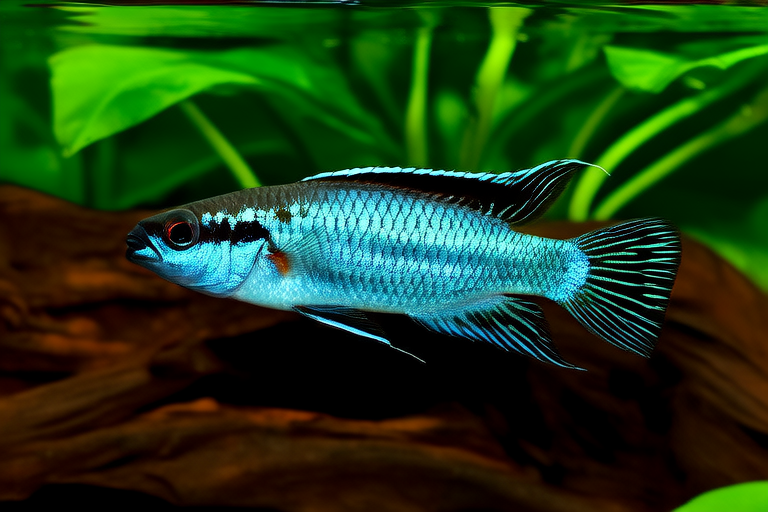Rajah Cichlid Care Sheet
Welcome to your comprehensive guide on caring for Rajah Cichlids, also known as Paratilapia rostrata. These vibrant, robust fish make an excellent addition to any freshwater aquarium. With this detailed care sheet, you’ll learn everything you need to know to ensure your Rajah Cichlids thrive in their new home.
Optimal Tank Setup
Tank Size
For one adult Rajah Cichlid, a minimum tank size of 55 gallons (208 liters) is recommended. However, due to their aggressive nature, it’s better to provide more space. A 75-gallon (284-liter) tank would be ideal for a single fish, and larger tanks are necessary for multiple Rajah Cichlids or when adding other species as tankmates.
Water Parameters
- pH: The ideal pH range for Rajah Cichlids is between 6.5 and 7.5. They prefer slightly acidic to neutral water conditions.
- Temperature: Maintain the water temperature at 72°F to 82°F (22°C to 28°C). Use a reliable aquarium heater to keep the temperature stable.
- Hardness: Soft to moderately hard water is best for these fish, with a general hardness (GH) range of 5 to 15 dGH.
- Ammonia and Nitrite: Both should be kept at 0 ppm. Regular water testing is crucial to ensure a safe environment for your fish.
- Nitrate: Aim for nitrate levels below 20 ppm. Perform partial water changes regularly to maintain low nitrate levels.
Filtration and Lighting Needs
Choose a high-quality filter that provides both mechanical and biological filtration. Canister filters are highly recommended for their efficiency and ability to handle large volumes of water. Ensure the filter can process at least four times the volume of your tank per hour.
For lighting, a full-spectrum LED or fluorescent light is suitable. Provide 8 to 10 hours of light daily, simulating natural day-night cycles. Avoid overly bright lights, as they can stress the fish.
Diet Recommendations
Rajah Cichlids are omnivorous, feeding on a variety of foods in their natural habitat. In captivity, they enjoy a balanced diet of commercial cichlid pellets, flakes, and frozen or live foods. Offer them a mix of high-quality cichlid pellets and occasional treats like bloodworms, brine shrimp, and other meaty foods. Feed them small portions two to three times daily, ensuring they finish their food within a few minutes.
Selecting Appropriate Tank Mates
Rajah Cichlids can be aggressive towards other fish, especially those of similar size or species. Choose tankmates carefully to avoid conflicts. Good companions include robust, fast-swimming species like Synodontis catfish, African butterflyfish, and some large tetras. Avoid slow-moving or timid fish that might become prey.
Regular Maintenance Routines
Perform weekly water changes of about 20% to keep the tank clean and maintain optimal water quality. During water changes, vacuum the substrate and clean the filter media. Regularly inspect the tank for signs of algae growth and remove any debris. This helps prevent the buildup of harmful substances and keeps the environment clean and healthy.
Breeding Information
Rajah Cichlids can breed in captivity, but it requires careful planning and preparation. To encourage breeding, provide a spacious tank with plenty of hiding spots and caves. Gradually increase the water temperature to stimulate spawning behavior. The female will lay eggs on a flat surface, and the male will fertilize them. Both parents guard the eggs and fry. Once the fry hatch, feed them infusoria or finely crushed flake food. As they grow, gradually introduce larger food items.
Common Health Issues and Preventive Measures
Like all fish, Rajah Cichlids can suffer from various health issues. Common problems include fin rot, ich, and bacterial infections. Maintaining excellent water quality, providing a nutritious diet, and minimizing stress are key to preventing these issues. Quarantine new fish before introducing them to the main tank to avoid introducing diseases. If you notice signs of illness, promptly treat the affected fish with appropriate medications.
Tips for Maintaining a Healthy Environment
To keep your Rajah Cichlids healthy and happy, follow these additional tips:
- Provide plenty of hiding spots and caves for the fish to feel secure.
- Use decorations that mimic their natural habitat, such as driftwood, rocks, and plants.
- Avoid overcrowding the tank, as it can lead to stress and aggression.
- Monitor the fish’s behavior and appearance regularly for any signs of distress or disease.
- Feed them a varied diet to meet their nutritional needs.
By following these guidelines, you’ll create an ideal environment for your Rajah Cichlids to thrive.
Conclusion
Caring for Rajah Cichlids is a rewarding experience for aquarium enthusiasts. With proper tank setup, water management, diet, and regular maintenance, you can ensure these beautiful fish remain healthy and vibrant. Remember to choose compatible tankmates, maintain excellent water quality, and provide a stimulating environment. By doing so, you’ll enjoy the company of these fascinating fish for years to come.
